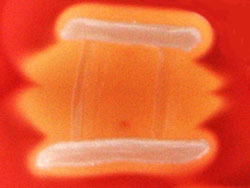
Organism Spotlight
|
Beta-hemolytic Streptococcus agalactiae (Group B Strep.) on 5% Sheep Blood Agar
Group B Streptococcus By Aaron Nisbet, Clinical Micro-STAT. Edited and Photos by Sopheay Hun, Clinical Micro-STAT Group B Strep (Streptococcus agalactiae), is a beta-hemolytic, Gram-positive bacteria that typically inhabits the intestinal tract of humans. It is serologically different than Group A Strep, which may cause strep throat and other infections. Group B Strep (GBS) is a common cause of illness and disease in pregnant women, the elderly, and adults with health issues such as diabetes and liver disease. More importantly, GBS infection is the leading cause of life-threatening illness in newborn children. As a group, Streptococci are nonmotile, nonsporeforming, and catalase-negative. Strep bacteria divide in one plane and thus form pairs or chains of cells. Individual cells are round to oblong and are 0.6 - 1.0 micrometers in diameter. They are facultatively anaerobic and require enriched medium containing blood in order to grow. Streptococci can be classified on the basis of several characteristics, including hemolysis and (most definitively) serologic specificity. They are divided into three groups depending on the type of hemolytic activity displayed on blood agar. Beta-hemolysis is a complete lysis of red cells surrounding a colony. Common beta-hemolytic species include the Group A and Group B Streps. Alpha-hemolysis is characterized by a partial lysis and is also termed “Green” hemolysis. Streptococcus pneumoniae is a common pathogen displaying alpha-hemolysis. Nonhemolytic colonies are termed gamma-hemolytic, and include the Group D Enterococcus and Non-Enterococcus species. Serological grouping is based on several factors, originally defined by Rebecca Lancefield. Antigenic differences in cell wall carbohydrates and cell wall pili-associated binding proteins facilitate serological grouping. GBS can be identified primarily by a distinct polysaccharide capsule on its cell wall. In the clinical setting, GBS is identified by growth on selective and differential medias, such as Columbia CNA agar. Subsequent inoculation with a particular group of Staphylococcus aureus will produce a very unique hemolysis of the agar. This “CAMP” test confirms the presence of GBS growth on the medium.
Approximately 19,000 adults and
newborns contract GBS infections each year before recent
prevention implementations. GBS in adults can be a mild as a
urinary tract infections or more invasive such bloodstream
infections, pneumonia, and infections in soft tissue, skin bone,
and join. Many others are carriers of the bacteria without signs
or symptoms of infection. About 25% of pregnant women carry GBS
in their vagina or rectum, and most are asymptomatic. In pregnant
women, GBS can cause infections in the womb, amniotic fluid,
urinary tract, and in incisions following cesarean sections. More
importantly, GBS can be passed to a newborn during maternity,
labor, and delivery. The bacteria can travel up the vagina and
infect the uterus; there is new evidence that GBS can pass
through membranes in the womb and infect the unborn child. They
may also be exposed when the mother’s membrane ruptures (water
breaks), as they pass through the birth canal, or if they swallow
or inhale the GBS bacteria during delivery. |

